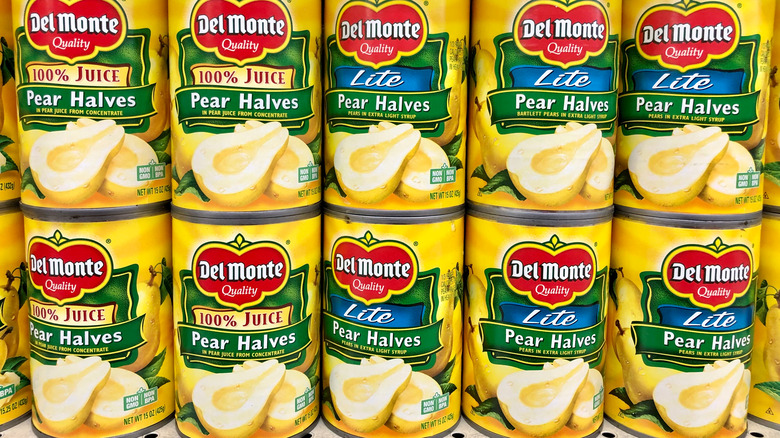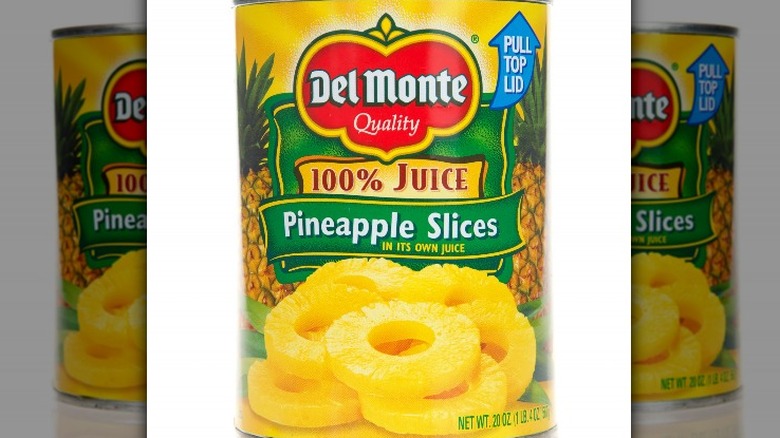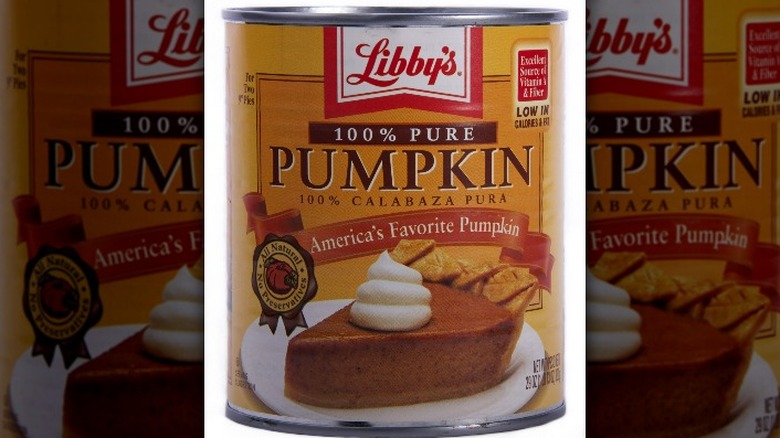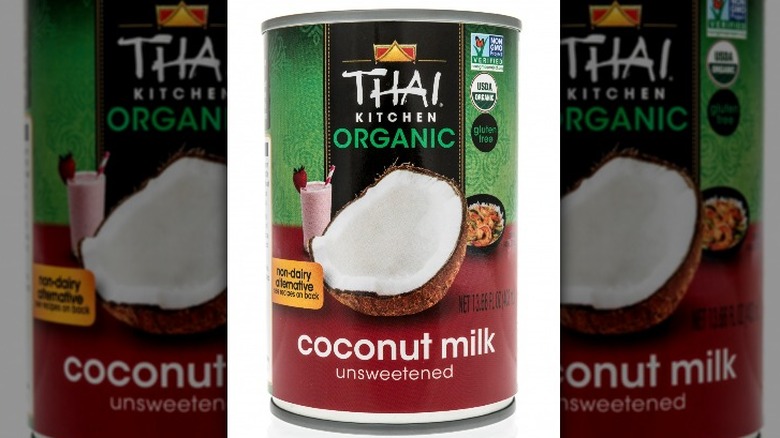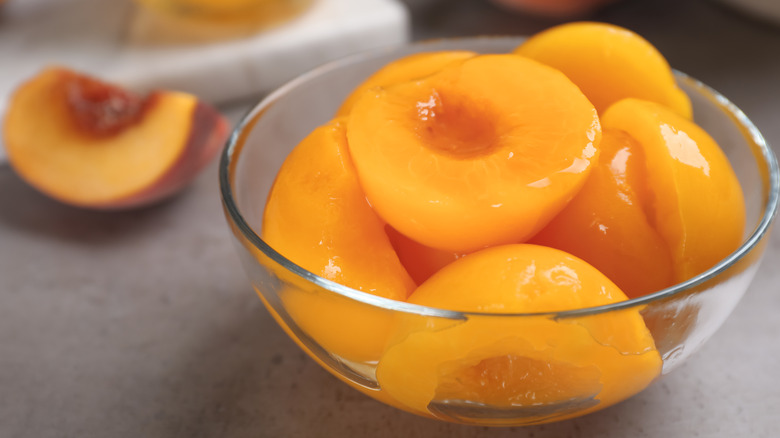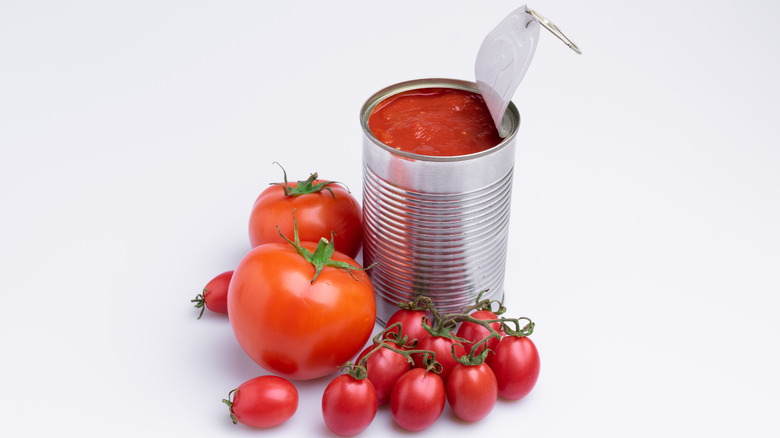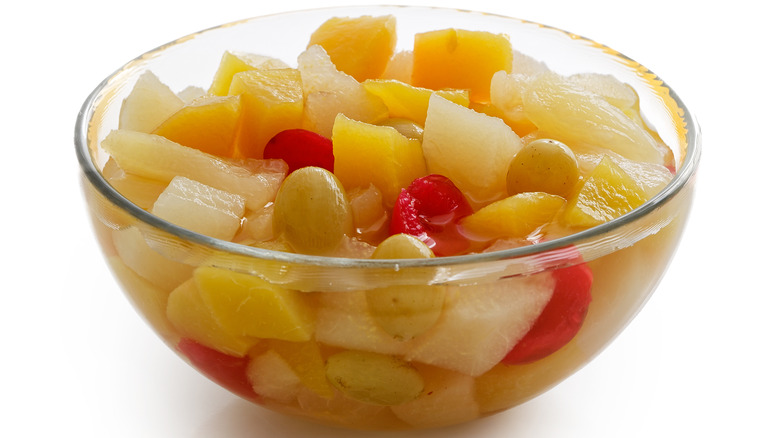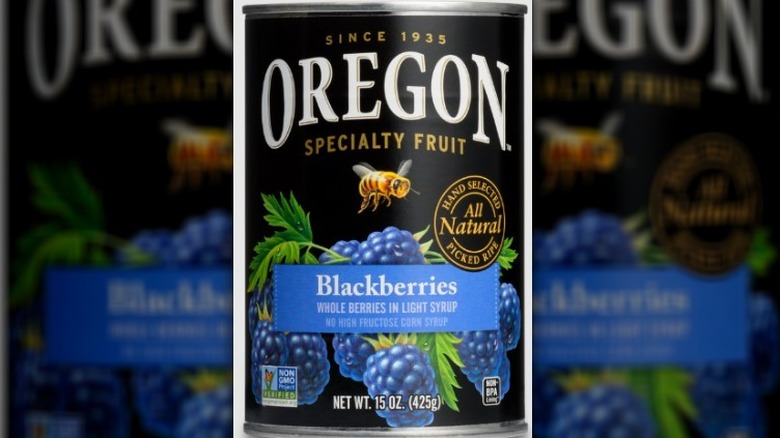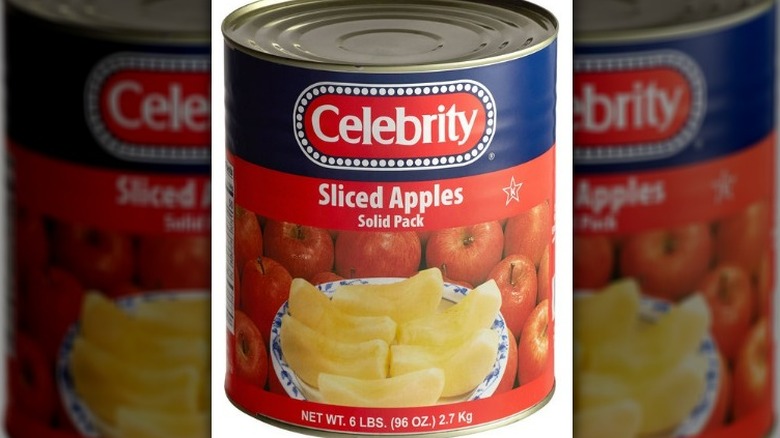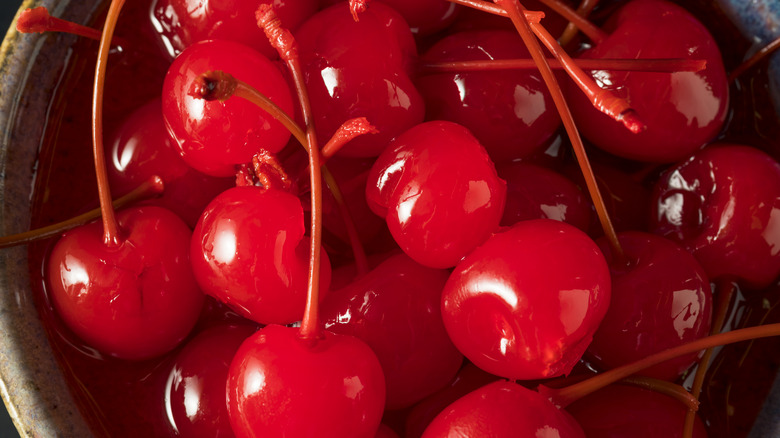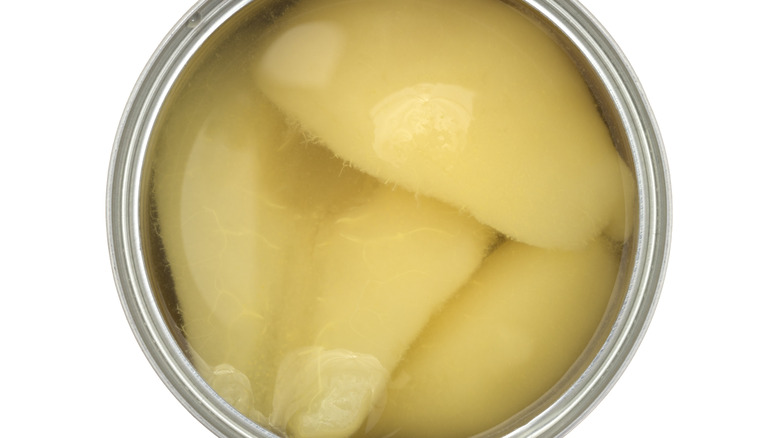5 Canned Fruits You Should Buy And 5 You Shouldn't
Canned food gets a bad rap, especially when it comes to fruits and vegetables. It's worth noting that human beings have been canning as a method of food preservation since the early 1800s (via Britannica) — you can thank the French for that invention. Originally, canning was a storage method born out of necessity. You can (not) thank capitalism and mass production — and the mandatory inclusion of preservatives like excess sodium, sugar, acids, benzoates, and nitrates (via ResearchGate) — for tainting the worldview on what's actually a pretty ingenious method of preservation.
All the same, remember to steer clear of anything that has been packed in heavy syrup (via Food Network). Opt for fruits stored in water, coconut water, or their own natural juices ... or light syrup if you're craving something syrupy. Be wary of "no added sugar" products because they often contain artificial sweeteners. Canned fruits are not only economical and versatile, but the Academy of Nutrition and Dietetics states that they remain almost identical to the fresh stuff when it comes to nutritional value.
Should fruit in a can be a kitchen staple? Yes, but it's worth noting that not all canned fruit is created equally. We'll walk you through which fruits are best to avoid and which you can freely enjoy.
Do buy: Pineapple
While a majority of pineapples consumed in the U.S. are imported from Mexico or Central and South America, fruits that are grown within the states primarily come from Hawaii, and small-scale farms in Florida, Georgia, California, and the territory of Puerto Rico (via Produce Blue Book). This regal fruit is available year-round, but it still has a limited growing season.
When you purchase pineapple during its prime months, it'll be the sweetest and juiciest of the year. Like all canned produce, pineapples are picked at the peak of the season, ensuring that you get the maximum nutritional benefits and flavor the plant will ever have during its growth cycle (via National Center for Home Food Preservation).
That being said, pineapple production can still fall victim to natural disasters, pests, and a whole host of negative external impacts that can affect the size, flavor, and price. That's one reason why you should keep canned pineapple at home — you won't have to deal with inflated prices or subpar fruits.
Nutritionally, pineapples are chock-full of vitamin C, B vitamins, manganese, potassium, and magnesium, to name just a few (via Cleveland Clinic). They're also the only fruit to contain the enzyme bromelain, which has anti-inflammatory properties and has been known to suppress the growth of certain cancerous tumors (and help that hangover if you had one too many shots).
Do buy: Pumpkin puree
We're talking about 100% pumpkin puree, not canned pumpkin pie filling (which has extra sugar and added spices). That canned sibling is a totally different — and not so versatile — animal. Canned pumpkin (or pumpkin puree) on the other hand, has had a bit of a tumultuous past. When news broke out that it wasn't made using your typical orange jack-o-lantern, people fell into a conniption.
Pumpkin puree is actually made with the Dickinson pumpkin, whose lineage can be traced back to the mid-1830s (via Garden Tabs). It's also not really a pumpkin but a squash masquerading as one. Dickinson pumpkins are known for their bountiful flesh because unlike their grim-grinning-gourdy relatives, they aren't hollow. They can also reach upwards of 30 pounds, making them the beast of the pumpkin patch and perfect for canning.
If you're wondering why you should keep canned pumpkin on hand, the better question is why not? This multifaceted fruit — yes, a pumpkin is technically a fruit, though Healthline reports that it's more nutritionally comparable to vegetables (the debate rages on) — is packed with vitamins and minerals. One cup of cooked pumpkin contains 245% of your recommended daily value of vitamin A, which is important for your eyes and cells (via Mayo Clinic). Pumpkin can also be used for more than just pie; it's great in soups, curries, and even hummus.
Do buy: Coconut milk
Do you keep a few dozen fresh coconuts and a coconut grater on hand for those moments when you're in dire need of coconut milk? (If you do, more power to you.) For the rest of us, it's usually easier to just keep a few cans on hand. When you're out shopping to restock your shelf-stable items, keep in mind that canned coconut milk comes in a few different forms.
For starters, coconut cream can be found in both a carton and a can. It has a higher fat content that gives it a rich, smooth, and thick consistency, which makes it an excellent candidate for recipes that omit dairy. Coconut milk is also available in a can and carton, but the latter is typically meant for drinking and less for cooking. Coconut milk packaged in cartons usually contains extra additives and sweeteners with a thinner liquid texture.
Canned coconut milk is the midway point between the two — it's still pourable (and drinkable, if you're looking to use it for that purpose), but it's thicker and more viscous, much like heavy cream. Canned coconut milk is an amazingly versatile food item that successfully crosses into both sweet and savory recipes.
Besides being tasty, coconut milk is darn healthy. It contains antioxidants and antimicrobials — which help keep your body free from disease — and MCTs (medium-chain triglycerides) which help convert fat into energy (via Medical News Today).
Do buy: Certain stone fruits
Stone fruits include pretty much any fruit containing a large pit; peaches, plums, apricots, and nectarines, are a few examples. According to the Seasonal Food Guide, in the Northern Hemisphere stone fruits typically only grow during the summer months from June or July until late August or early September.
Besides having a relatively short season (if you compare them to fruits like bananas, lemons, and oranges, which are readily available year-round), stone fruits fall under the quickly perishable category. They're incredibly delicate and with one small bruise, you can expect the lifespan of that sweet-fleshed fruit to seemingly dwindle overnight (via Stop Food Waste). And what do you do if you end up with a bunch of peaches, apricots, or nectarines that are all about to go south? You either eat 'em, freeze 'em, or (you guessed it) can 'em as is or turn them into jam and jelly.
To make matters worse, the past two years have had a profound impact on the cost of stone fruit production, as reported by Agri-Pulse. California's central valley (dubbed America's Fruit Basket) is responsible for growing more than 80% of the country's stone fruit. California's stone fruit industry costs have risen 45% since 2020, which is ultimately reflected at the cash register. So in this case, keeping canned stone fruits in your cupboards is an economical way to get your off-season fix.
Do buy: Tomatoes
Canned tomatoes — another example of a biological fruit that is nutritionally more similar to vegetables — are sometimes avoided by consumers for fear of botulism or BPA. Luckily, botulism generally only occurs in low acid foods (not the case for tomatoes, per Techie Scientist) or those that are processed using poor home-canning techniques. Therefore, it's relatively uncommon for these little red globes of goodness to cause this deadly illness (via National Library of Medicine). Still afraid of BPA-laced cans? Don't be. BPA-lined cans are no longer used by U.S. tomato packing facilities. Plus, the label typically indicates whether a can is BPA-free or not.
In their fresh form, tomatoes are packed full of vitamins and minerals, like calcium, potassium, and folate. But canned tomatoes have a little extra trick up their non-existent sleeves. As they are cooked, the heat actually opens up the fruit's cell membranes — kind of like the way steam opens up your pores during a facial. This means that your body now has the ability to absorb even more of the plentiful antioxidants and nutrients tomatoes have to offer — especially the cancer-fighting compound lycopene (via Medical News Today). So in the case of the magical tomato, fresh is great but so is canned.
Don't buy: Fruit cocktails
Fruit cocktails are iconic and steeped in American culture. In fact, you've probably encountered the snack at least once in your life (whether it was in your school lunch or at a dessert table suspended inside an electric green jello mold). It's thought that this rainbow-colored canned good arrived on the scene sometime around 1930, according to Mercury News. In post-WWII America, it was considered a healthy alternative for families who had limited access to fruit. And while accessibility has changed a bit since then, fruit cocktail is so celebrated that it even has its own National holiday.
But what exactly is it? The FDA has some strict guidelines (no joke!) about what constitutes a true canned fruit cocktail. It has to contain 30% to 50% diced peaches, 25% to 45% diced pears, 6% to 16% diced pineapple, 6% to 20% whole seedless grapes, and 2% to 6% sweet (artificially colored) cherries.
One cup of canned fruit cocktail contains 44.4 grams of sugar, as documented by Eat This Much. However, the American Heart Association recommends a maximum of 36 grams of sugar for adult males and 25 grams for women daily. Maybe that's why Fitday suggests fruit cocktails as a good alternative to candy.
Don't buy: Berries
In their natural state, berries (blackberries, raspberries, strawberries, blueberries, etc.) are at their best in the summer months, starting from May until the beginning of September. Once their season is over, the price begins to hike up while the quality diminishes. Your berries will be smaller, duller, sometimes shriveled, and basically lifeless.
These little fruits are full of antioxidants, like anthocyanin, resveratrol, and ellagic acid (via Healthline). According to Verywell Health, anthocyanins give these fruits their pigmentation and help protect them from the elements. Though the research is still in preliminary stages, berries and other fruits high in anthocyanins might help reduce the risk of heart disease and contribute to preventing breast cancer. Furthermore, a 2014 study published in the Journal of Agricultural Food Chemistry demonstrated that berries contain anti-inflammatory properties.
It might seem smart to keep canned berries in your home, but there's one major health-defying ingredient you're going to want to look into first: sugar. The U.S. Highbush Blueberry Council states that a 1-cup serving of fresh blueberries contains 14 grams of natural sugar, while the same serving size of frozen blueberries contains 12 grams. When it comes to canned blueberries — in light syrup, no less — a ½ cup serving contains 22 grams of sugar (via HEB).
If your favorite berry isn't in season, skip the can and go for frozen. Sure, canned berries are great for desserts and toppings, but they'll also put you into a sugar coma and counter all of their benefits.
Don't buy: Apples
You know it's apple season when the leaves on the trees start turning warm reds and oranges and pumpkin spice treats makes their annual appearance. The fruit's main harvest season is late August through mid-November which is when you'll taste it the way that nature intended — bright, flavorful, sweet, and crisp. From a shopping perspective, one of the best qualities of apples is that you can purchase them year-round, and they're still pretty affordable (via Produce Business).
While eating an apple a day is meant to keep the doctor away (it's a plausible theory — Healthline states that apples have been linked to improved bone health, protection against asthma, and cancer prevention), canned apples probably aren't as beneficial. In fact, they could even have a negative impact on your overall health. One serving (1 cup) of canned apple slices contains 30.6 grams of sugar (via FatSecret). The same serving size of fresh apples entails consuming a mere 13 grams of sugar — none of it refined (via Nutritional Value).
Because of their easy availability, there's really no reason to purchase canned apples, unless you're making pie. Even then, homemade pie filling is pretty simple to make and doesn't include the syrup and additives you'll find in packaged versions.
Don't buy: Maraschino cherries
Ah, the maraschino cherry. It has conquered the tops of sundaes, swam around in cocktails, and been suspended in jello molds. According to Oregon Encyclopedia, the bright cherries were first created in the late 1920s. Wealthy Americans brought preserved maraschino cherries over from Europe, and Oregon farmers wanted to compete with that market. The problem with this particular cherry — the Queen Anne —was that it spoiled quickly and basically turned to mush when undergoing the proposed preservation method.
So, Oregon State University professor, Ernest H. Wiegand, created the actual preservation process that's used today, which includes adding calcium salts to the cherry brine. Oregonian food scientists piggybacked on Wiegand's recipe and created a process that included bleaching (you read that right!) the cherries so that they could be dyed unnaturally bright colors.
While maraschino cherries do have one or two legit purposes — they're good on sundaes and a key ingredient in a Shirley Temple recipe — keeping multiple jars stashed away for snacking probably isn't the best move. By the time they reach the jar, they're no longer really cherries. Per the FDA, everything about them is fake ... the flavor, color, and definitely the cloyingly sweet syrup they're swimming in. Instead, opt for sour or tart cherries in light syrup. They're not sickeningly sweet, but they get the job done.
Don't buy: Pears
Yet another fruit that should be added to the "I bruise easily" list; pears come in over 3,000 varieties worldwide (via Medical News Today). All the same, you're probably most familiar with Bartlett, Bosc, and Anjou. These fruits are touted as being packed full of water, fiber, and fructose, making them ideal for individuals with digestive issues. They're definitely considered high in sugar with 14 grams per cup (via USDA). Canned pears in their own juice or light syrup contain even more sugar per serving and those in heavy syrup are even worse.
But the biggest reason you should consider abstaining from canned pears is that depending on the brand, whatever's inside likely does not come from the U.S. According to the Yakima Herald, since 2001 consumers have shown more interest in fresh pears, which has been detrimental to the Washington and Oregon canned pear industry. It doesn't help that the U.S. imports canned pears from China because they're several dollars cheaper than those canned locally.
Eat Canned Pears notes that as of 2022, there are only three American-based pear canneries in operation: Del Monte, Neil Jones, and Pacific Coast Producers. So if you're still interested in giving canned pears a go, remember to look for the label indicating they are made in the USA.
